Cold Climate Permaculture Plants: Sea Buckthorn
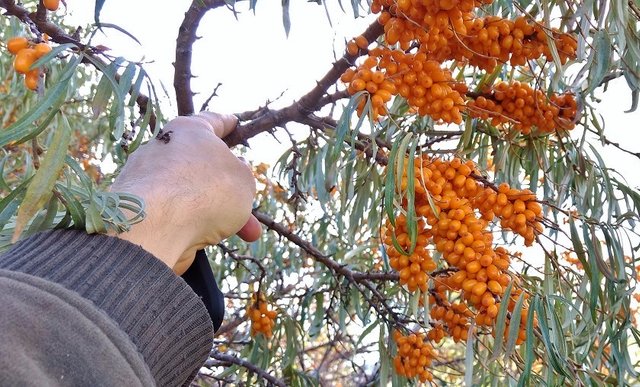
In the first edition of Permaculture Plants, I will be discussing one of the hardiest and most versatile shrubs that I know of, Sea Buckthorn! I have wanted to do a permaculture plants series for awhile but have been putting it off like a homework assignment for some unknown reason.
In this series, I will mainly be focusing on temperate permaculture plants, not only because I am already more familiar with them but because our property will be able to directly benefit from the additional research I will be conducting; many of the plants I will be highlighting will be utilized on our homestead.
Now, with the introduction out of the way, on to the plants!
Sea Buckthorn
Description
Common Sea Buckthorn (Hippophae rhamnoides), also known as Seaberry is an extremely versatile, large, nitrogen fixing shrub that is native to Europe and Asia. They have slender silvery green leaves, dense thorny branches and an equally dense root system, making them great for stabilizing loose soils. They are dioecious, which means there are both male and female plants.
Currently, Sea Buckthorn is most densely distributed in China, where there are large areas of both wild and cultivated plants. Because many of its many useful attributes, it is gaining a wider distribution in other countries like Canada. They will grow in a multitude of conditions, from sandy and dry to moist clay soils. In the wild, Sea Buckthorn can be found in coastal areas, along rivers and also in rocky mountainous areas and it is cold hardy from USDA zone 2b to 7.
Sea Buckthorn has a high saline and pollution tolerance making it ideal for repairing the most damaged soils. Historically, they have been used to help stabilize sand dunes on the eastern coasts of the United Kingdom and, in some areas, have continued to spread to the point of being considered invasive. Now, that is my type of plant!
 This Sea Buckthorn thicket is located on a large median in Edmonton
This Sea Buckthorn thicket is located on a large median in EdmontonI have noticed that they are often planted around Edmonton as ornamental shrubs near parking lots or in road medians where they would be exposed to saline, from the winter road salting, and plenty of exhaust pollution from all the heavy traffic. They seem to perform beautifully despite these harsh conditions.
Uses
The most obvious reason for growing Sea Buckthorn would be for the extremely abundant berries which, rightfully, can be considered a super food. These berries are absolutely packed with nutrition; containing extremely high concentrations of vitamin C as well as A, E, K and other nutrients. They also contain the full host of Omega fatty acids—3, 6, 7 and 9. There are named varieties of Sea Buckthorn that have been cultivated for significantly larger berries.

The berries can be a bit difficult to pick because they don't easily detach from the branch and tend to be damaged in the process. Due to this, and the berries extremely tart flavor, they are often used in juices, jams and other preserves rather than for fresh eating. They are also a popular ingredient in natural cosmetics due to the high levels of omega fatty acids and anti-oxidants.
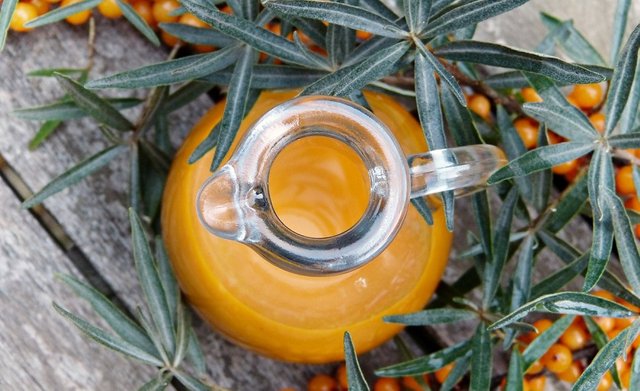 Source
SourceThe leaves of the plant can also be used as a medicinal tea. They have a mild green tea like flavor and have been shown in a couple of studies to have anti-oxidant and liver protective qualities. The leaves also contain up to 24% protein making them a great livestock feed. In fact, the first part of Sea Buckthorns Latin name Hippophae loosely translates to "shining horse." The ancient Greeks supposedly fed the leaves to their horses to impart a shiny coat.
Sea Buckthorn can grow anywhere from 10-20 feet tall and are considered a large to extra large shrub. They would fit into many permaculture designs in layer 2 (sub canopy) or layer 3 (shrub layer) and make a great companion plant or guild plant because they are nitrogen fixing and will enrich the surrounding soil. Caution needs to be taken that they aren't shaded out too much because they do prefer full sun and may not perform well in heavy shade. Due to their thorny nature, they also make great perimeter or boundary plants if planted in tight rows.
Growing Conditions, Propagation, and Maintenance
As already mentioned, Sea Buckthorn can thrive in a variety of conditions. They prefer full sun but can tolerate partial shade. They can also tolerate both dry to wet soils as long as the soils are well drained, and can tolerate a wide range in soil pH, from 5.5 to 8.5.
Both male and female plants are needed for fruit production and the most efficient ratios of male/female plants are said to be 1/8-10. Pollination occurs by wind only so strategic placement of the male plants in relation to the females might lead to greater production. Fruiting occurs most on two year old branches so if you are interested in maximum production some pruning could be beneficial.
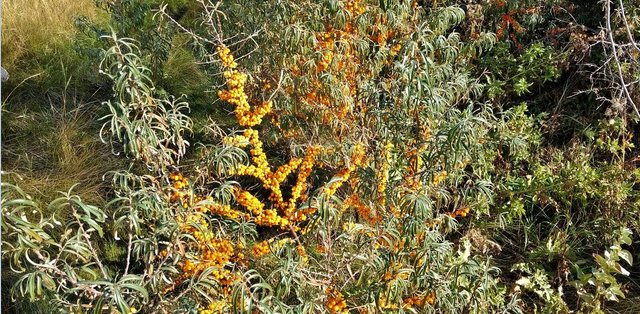 Look how these small plants are just loaded with berries!
Look how these small plants are just loaded with berries!Sea Buckthorn can be propagated in a variety of ways: by seed, soft or hard wood cuttings, layering, and also by transplanting suckers. If you decide to start from seed you may need to wait several years before the plants are large enough to be able to identify their sex. The seeds will yield approximately 50% male and female plants so if planted in the ground some of the males may need to be removed and replaced with females to maximize fruit production.
Sources:
https://en.wikipedia.org/wiki/Hippophae_rhamnoides#cite_note-Ruan_2010-14
https://tcpermaculture.blogspot.co.uk/2012/07/permaculture-plants-sea-buckthorn.html
http://coast.hope.ac.uk/media/liverpoolhope/contentassets/documents/coast/media,25634,en.pdf
Fantastic post. I've been growing 6 varieties for about 5 years now. They're just starting to get big enough to produce a reasonable crop. I use a lot of it, I'm finding it takes about 30 plats per person if you intend to have it daily, but the berries do freeze well.
In terms of propagation, I let my chickens scratch under them. That mild disturbance of the surface roots triggers suckers to come up by the thousands, which can be grown out for a season before being moved.
I'll be scaling up to about 600 plants this year. I'm definitely following your posts.
As for de-stemming the berries, if you can take the whole branch (pruning at the same time), just stick the whole thing in the freezer, and when frozen, wrap with a towel and whack it on the counter. Not helpful for large harvests but for anyone with 3-6 bushes in their backyard, it works great.
I haven't used the leaves for tea, will need to try that. However, the berries are probably one of the best-tasting fruits when they undergo a lactofermentation. Juice them and get a lambic beer culture from your local brew shop, and just pitch it in and leave it on a warm countertop for a week, then add in a bit of honey, cap the bottle and let it set for another two days to build some effervescence. Serve chilled. Also benefits from a cardamon seed in each bottle. It will be mildly alcoholic (<2%), but very refreshing.
Keep up the good work.
Thanks for reading and the support!
I was aware of the freezing the whole branch method but have yet to try it. That fermented juice sounds amazing will also have to try it.
600 plants? Are you planning some sort of commercial production?
I actively grow for a local charity that installs food-producing plants in low-income neighborhoods. The poor do have disproportionate health problems resulting from diet. When a quart of seaberry juice costs $18, I can't afford it, and someone in subsidized housing living off of fast-food dollar menus sure as hell can't. I'm generally against state-run welfare systems, but I can't in good conscience advocate for their defunding without offering a better alternative solution. Though I believe the dependence on those welfare systems is illegitimate in many cases, people are nevertheless dependant on them. Until that dependence is broken, those systems will only continue to expand. This is just the one alternative idea I'm able to meaningfully contribute towards.
Food is the highest expense of living, and medical care for disease brought on by poor nutrition is a close second. Our admittedly lofty goal is to get 10% of those below the poverty level to the point where they can eat from their gardens 1 day a week.
What I've discovered though, many of the people we plant these for haven't the time, experience or interest to maintain the plants. The group did a few hundred apple trees about 5 years ago, and maybe 10 of them are still alive today. So to move forward, we need perennial plants that grow easily, aggressively, and are very hard to kill. This hits all the criteria. Rugged, accepting of abuse and neglect, nutritious, and would normally be beyond the financial reach of the people we're planting them for. The nitrogen fixation is also a nice bonus, as the soil in many of the older city lots is so depleted, it requires major remediation. These will grow in anything.
Also, we need to scale up to get NPO status, which will make my donations tax-deductible (They technically are now, but it's contentious). I can turn 1 plant into 20 in two years, so it's a low-cost way to get thousands of plants out there, and move enough value through the organization that we can make a case for a legitimate non-profit status. I'm not really involved with that part of it, but will do my part as one of the growers... a tax break is always welcome, lol.
I followed you and expect to see a post on how you are cloning or starting these plants!
Sure thing...
I'll upload a better video when the weather is more conducive to it, but I've been wanting to run through the DTube upload procedure (test upload), so here's a short clip of the patch up near my house.
I'll be potting them up or transplanting sometime in March or April, so I'll do a complete video then.
:D
I didn't expect an immediate post LoL, I was thinking when you were ready. Thanks for taking the time to share though.
That's really great! So many good people here on Steemit.
Once I get the bigger house built this year the next major project will be to get a nursery going. In order to afford the amount of trees I want to plant on our land I am going to have to grow a lot of them myself. I planned to sell some too to cover costs. I will have to remember to set aside some for charity work too. I like this idea. The whole teach a man to fish thing.
Thanks for sharing.
Funny coincidence, just a few hours ago i made raw sea buckthorn juice.
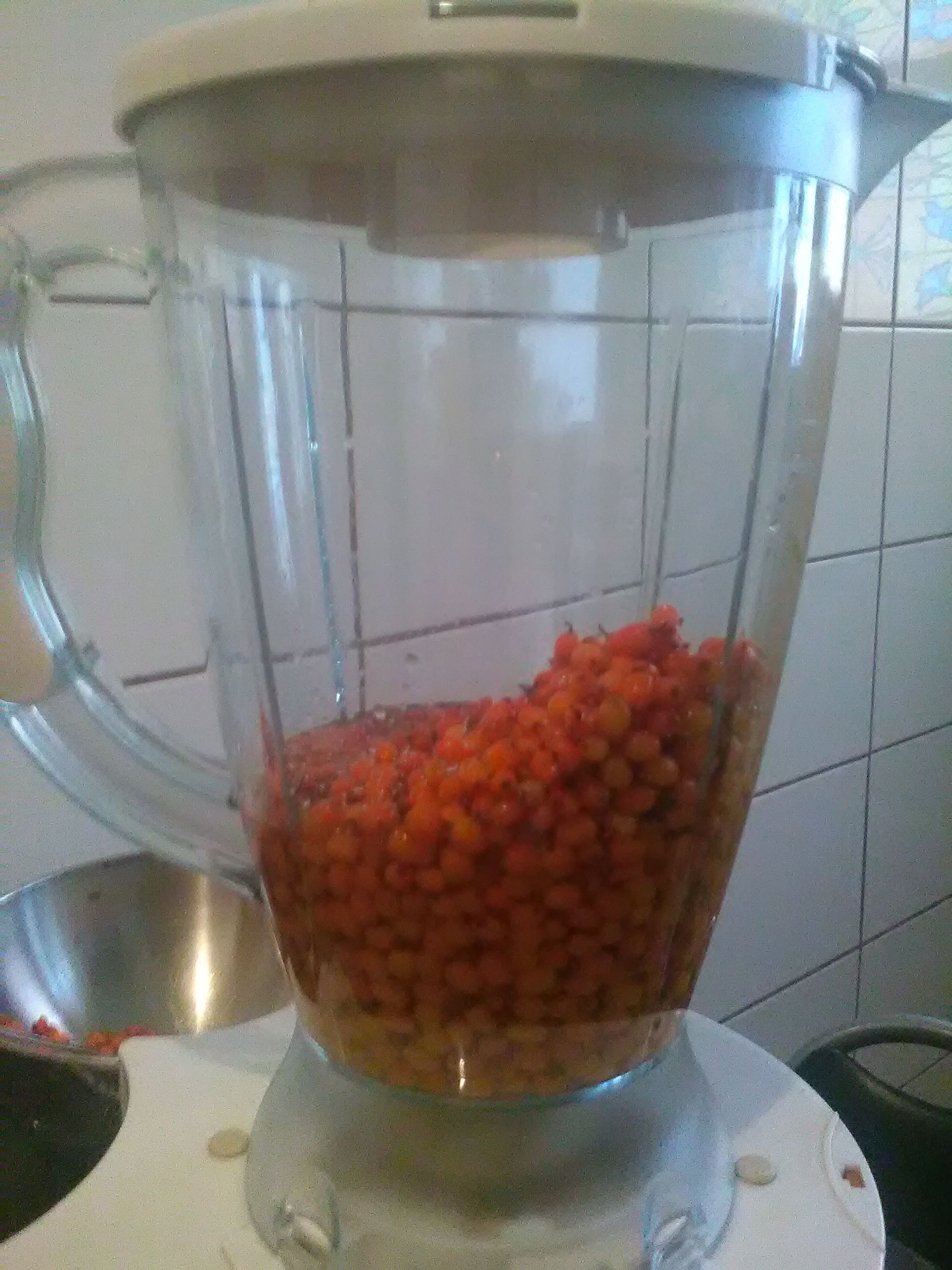
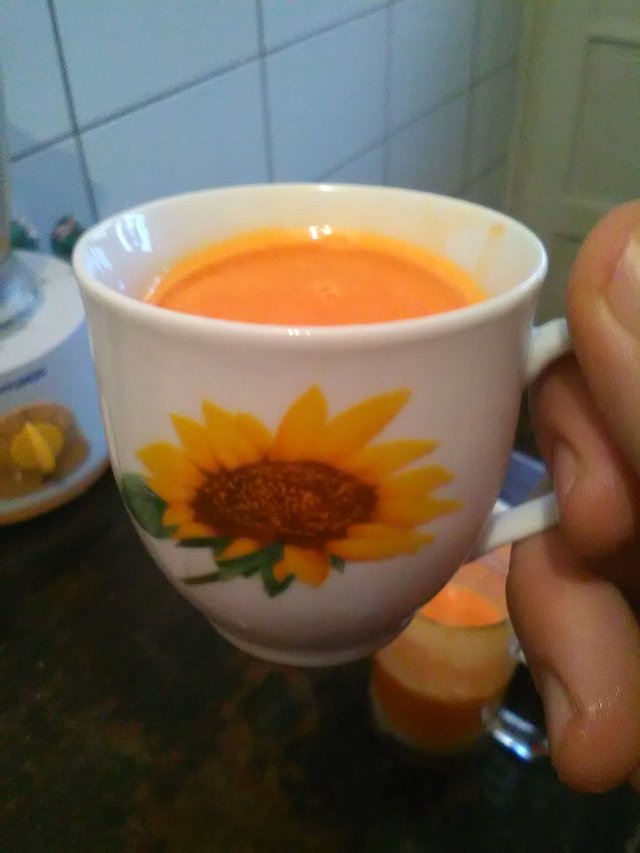
Cheers!
That looks like a pretty hardcore juice. How about some tasting notes?!
It has an astringent taste and it's very aromatic.
It's like comparing grapefruit to oranges, you either like the grapefruit or you dont.
I personally freeze the juice in ice cube flats, and put one cube in my thermos in which i have warm tea, and at the end of the working day it's starts to ferment and the tea tastes like beer/borsch.
I love grapefruit. I must try some!
Cheers.
Cool! I have only eaten them whole so far. I want to get into juicing them though.
That's cool. We are in Hudson's Hope, near Fort St. John and were just pointed in this direction by @mountainjewel. I'll be asking the nursery about these tomorrow. Thanks.
Awesome, thanks for stopping by! It is always nice to bump into another Canadian.
Wow. I’ve been trying to hold my eyes open while I’m reading posts for the last couple of hours, I’m so sleepy! But this one woke me up. I’m definately going to look for a start of Sea Buckthorn to get going this year. The only other time I’ve heard of Sea Buckthorn was a small mention in one of your other posts. I’m so glad you did a full article on it.
Thanks! It is such a useful plant I am glad that I can introduce some people to it. It seems to grow like a weed around here (as long as the damn deer don't eat it!.
I’m still in town and the deer here seem to think that anything planted outside of the back fence is there for them. SMH.
Another tip: you mentioned the use for horses, and as fodder but seaberry is especially prized by rabbit breeders for fur conditioning, especially for angora rabbits. During harvest, whole branches are trimmed, the berries shaken free, and the left over branches and leaves can be fed to the rabbits directly. It's considered a must-have for rabbitries.
Interesting! I did not know this.
This is why I love Steemit. I get to learn about edible plants I may have never heard about otherwise. Thanks for sharing!
You're Welcome!
What an informative post! This Sea Buckthorn is just like a coconut tree, from the roots to the fruits and leaves, it has many incredible uses. And the branches are so beautiful to look at with the berries loaded! I would have planted this in our backyard if we have it here in our country.
I think where you live it is too warm. They like cold winters.
As you say - they need some sweetening to make them really edible.
Very useful in a hedge.
Nice series - although PFAF (plants for a future) are way ahead of you!
Yeah, there are a few plant databases already. Not on Steemit though and I get to educate myself more and put my own spin on it!
Fair play on both accounts.
Great article sir with nice photography... 👍
Thank You!
Very cool! When I first read the title, I had to read it again because as you mentioned in the article, Sea Buckthorne is often used in beauty treatments. I just didn't think the Canadian Renegade would be worrying about crow's feet and laugh lines. (I know Aimee writes articles too, but I always think of Matthew first since his face is right there.) I don't have much of a skin care regime myself, but there was an herbalist back in California that made a soothing skin cream with it and for some reason the name of the plant stuck with me.
Glad to know that it's so good for permaculture! We're going to be finishing up a fence with corrugated metal (like the outside of a shop) this spring, and the front side of the fence faces the road but gets full sun. The only issue is the snow collects there in the winter because of the plows. Have you grown them personally? If so, how did they do in the snow?
I have grown them! I have some I bought as yearlings. Had them for 3 years now, so I guess they would be 4 year old plants. Just started getting a crop off of them.
They have done well, except the pesky deer like to eat the tender new shoots in the spring and have stunted their growth. They leave the older branches because the older branches have the thorns.
I don't think snow will hurt them at all unless we are talking about the snow forcefully being pilled up against them. But that would apply to pretty much any shrub or tree.